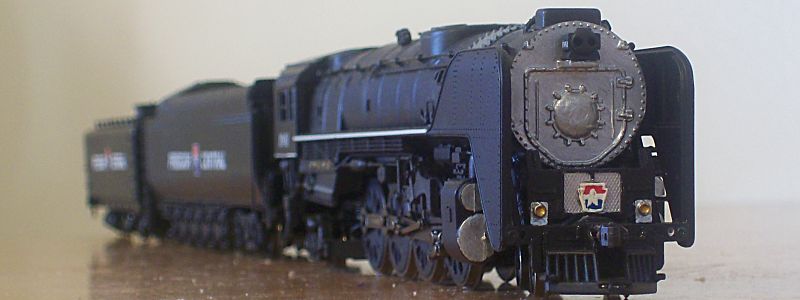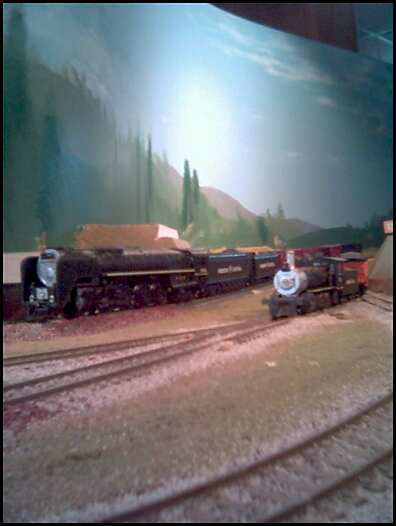




Though the Freedom Central began as plans for large scale railroading, there eventually came a time when other scales became an option for expanding the Freedom Central model empire.
After I started the development work trying to integrate the existance of the heavy pacific into the A&A's history, I had a dream one night. That dream left only one memory, the scene of a NYC 4-8-4 S1b Niagara type steam locomotive thundering over the New York State 8-lane Thru-Way while towing along a solid double-stack intermodal train. No one offers a Niagara in large scale and if they did it would be astronomically expensive. As a result I decided to splurge and purchased an HO scale Niagara from Bachmann.

As you can see from the above image, I left the engine near-stock. The cab number and tender lettering were redone to Freedom Central, but other than the over-fire jets being converted to the air-intakes for a Gas-Producer Combustion System (GPCS) firebox, nothing else was altered from the side. One thing I'd like to do is modify the smokebox to a dual-exhaust stack, but thats all.
As a modern-era steam enthusiast, I knew that rebuilding the infrastructure needed for coal-fired steam operations was simply not realistic. Concessions to modern diesel-electric operations would be needed, hense the adoption of technologies similar to those developed for the ACE-3000 project. As a result, I wanted to add an auxilary water tender, ie "canteen". My original hopes were to get one of the fuel tenders used by Union Pacific's steam locomotives. Unfortunately, they weren't available at the time I purchased.
The Norfolk & Western tenders originaly used by the 2-6-6-4 Class A steam locomotives and then used by Class J 4-8-4 No.611 and Class A 2-6-6-4 No.1218 during their operations with the original Norfolk Southern Steam Program; which was terminated in 1994; was available in HO scale. So I ordered one of them. Both the main tender and the auxilary water tender were decaled for the Freedom Central in the "NewAge" design. Since this would not be a "Heritage" engine but a new-build, the FRA's excemption from modern appliances would not be available. Concessions such as speed & event recorders, crew alerter, and other modern safety appliances were integrated during the design stage in order to have as minimal impact to the engine's appearance. One detail not easily hid (for a reason) would be the ditchlights.

The ditchlights were little brass castings superglued to the front of the air aftercooler shield. This provided both a super stable mounting as well as a logical location to place them. Painted silver, they contrast with the shield in the background, increasing visibility. I used a little dab of orange turning signal paint to "light them up". But someday, I am thinking of running a couple of fibers down the from the smokebox to really light them up. Got to love the expansion of technology from pure high-tech to th elittle-guy hobby market. Who would have thought cheap fiber optics would be available for modelling purposes fifteen years ago?
As you can see in the above image, the front end recieved the most number of changes. First, I had to grind off the New York Central railroad and number plates. I didn't have nearly as much experience (or tools) as I do now, resulting in a far less than stellar finish. Maybe some day I'll tackle this engine again and try to clean up the door. Part of the "NewAge" motif is the use of silver on the smokebox and cylinder heads. I was always partial to the RioGrande excursion/tourist motif. I however go with the same argument Southern Pacific used which was that the silver provided increased visibility at crossings. This goes with my arguements that safety and design can be integrated at the start. Safety doesn't have to be an ugly afterthought addon. In this case, increased crossing visibilty is designed into the railroad's corporate image through the use of silver on the smokebox as part of the locomotive's paint scheme. On all other engines, the entire smokebox is silver. Because of the smoke deflectors (aka elephant ears) I had to consider the different possibilities. I ended up just painting the front of the smokebox silver as I couldn't envision any design that would look good as well as enhance the engine's visibility.
The final addition was the Freedom Central Keystone. I had located a package of non-detailed brass pennsy number plates. Using the finest paint brush I could find, I was able (barely) to paint on the keystone logo. The design is the Freedom Central's official logo for the railroad. It is based on the PRR keystone (obviously) but the innards come from the American Freedom Train. On the tail of No.4449's tender and on each end of the passenger cars, three stars were painted in a field of red and blue. The white line ran through the stars connecting them all. I chose one single of these stars linked to the keystone border to create the logo. Each engine of the Freedom Central carries at least three such keystones. One on the nose and one on each side in the banner. It's its all part of the "NewAge" paint scheme.
After purchasing the engine and tender from the local train shop in Arcade, I had Ricky Rupp of Modern Rails do up the decals and apply them for me after I got modifications and paintwork complete. Modern Rails did all the original artwork and decals for the Freedom Central Railway and I wanted to give him the business as he was just getting into the smaller scales at that time. After the engine and tenders were complete, I took them to visit their little cousin. Before I moved to Pennsylvania, I worked for the real Arcade & Attica Railroad. In late-2002/early-2003, I was part of a group that was converting the second exhibit room at the Arcade Station into a full-size layout room. We designed a double-loop HO scale model railroad that covered the entire Arcade & Attica line from the Blue Seal mill at the Pennsylvania Railroad interchange in Arcade to the State Prison at the Erie Railroad interchange in Attica. Before I left Arcade I decided to get a couple pictures of my engine on the A&A layout.
 |
Why do all this? Well, I WANTED a niagara and at the time the Bachman unit was the only one available unless I wanted to jump to Lionel prices and scale; ya, right. After purchasing the next thing was to make the purchase worthwhile. A locomotive without a train is just a hunk of scrap metal. I began considering my options. My first thought was the construction of a Freedom Central excursion train, which would be the primary use of a Niagara on the FCR system. I purchased a "Harriman" heavyweight coach and a Pennsylvania Railroad heavyweight observation. I planned to add a dome and a couple more cars down the road once I'd settled on final design for the Freedom Central's passenger paint scheme. But, the Niagara was originally envisioned for a specific purpose and after writing the story "I dream of Niagara", the locomotive's purpose to the FCR was quite clear. It was quite litterally what the S3a was built for.
So, as I could find them, I began assembling a massive collection of intermodal train cars. Gunderson smoothsided and Thrall ribbed "well" cars for double stacking intermodal containers. Dual-purpose flatcars and articulated spine cars for both containers and trailers. After hiring on with Norfolk Southern in 2004, I learned first hand about much of this equipment and began collecting containers in the road names of companies I found appealing. In addition to the standard intermodal equipment, I also saw teh standard 89-foot multi-level enclosed autorack cars and the later-developed articulated "Auto-Max" autoracks. These also piqued my interest and I planned to acquire some of these cars as well. Thankfully I hadn't gotten to the point of paying premier prices for the autoracks when I decided to sell off all the intermodal equipment.
I had originally planned the intermodal train when it looked like I was going to be a part of a group that was designing HO modules. When that future ended, the massive fifteen-foot long intermodal train lost its purpose. I kept the equipment for a while hoping to one day run the train, but eventually realized it wasn't going to happen and sold off the entire lot. Going forward, I will concentrate on the passenger train. At least that will look authentic to people if it ever gets to run.


